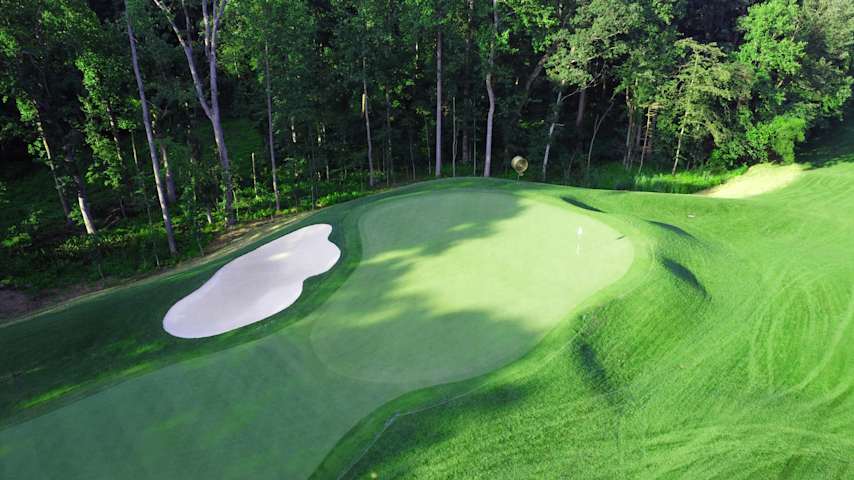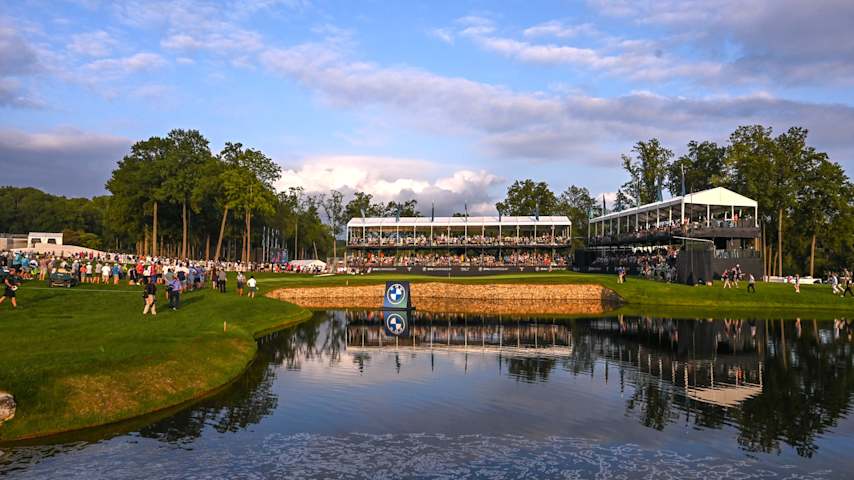Go inside the extensive renovation at Caves Valley, site of this week’s BMW Championship
6 Min Read

Massive 100-day renovation at Caves Valley | BMW Championship
Written by Paul Hodowanic
OWINGS MILLS, Md. – Kyle Steidel would forgive anyone had they walked onto Caves Valley Golf Club’s first tee, stared down the fairway corridor and questioned whether it was the site of a nuclear accident.
“It almost looked like a bomb went off,” Steidel, the course superintendent, remembers.
No, Caves Valley, the 35-year-old Tom Fazio design tucked in the northwest suburbs of Baltimore did not become a testing ground for fission and fusion, though it did resemble ground zero during the summer of 2023 as the club took on an extensive renovation to modernize the course for members and prepare it for the PGA TOUR’s return at this week’s BMW Championship.
Numerous holes were significantly reworked, the aforementioned first hole among them. Every green complex was ripped up and rebuilt anew, some looking nothing like previous versions. Different grass types were planted to promote firm and fast conditions. Ten miles of drainage system, a complex agronomic skeleton that lies beneath the entire property, was installed. Forty-five thousand cubic feet of dirt were moved on the first hole alone during the 103-day renovation that overhauled the club.
“You think it’s a lot, but to actually see it is something else,” Steidel said.

Massive 100-day renovation at Caves Valley | BMW Championship
Plenty more eyes will see the finished product this week when the FedExCup Playoffs return to Caves Valley for the first time since the renovation. The club hosted the 2021 BMW Championship, which Patrick Cantlay won in a war of attrition, besting Bryson DeChambeau on the sixth playoff hole. Even before the TOUR arrived back then, the club was seriously considering a full-scale renovation, and they emerged from that week fully set on their plans to improve the course for everyday play and championship events. Mainly, the course needed better drainage, and the club saw several strategic shifts to the layout that could make it more interesting for members and more challenging for the pros.
“Much of what we’re going to see (this week) had been on the drawing board for some time, but the championship brought everything forward,” said Buddy Marucci, the famed lifetime amateur standout who served as lead consultant for the renovation.
The foundation for the renovation began with the ground and what lies underneath it. As a typical Mid-Atlantic course, Caves Valley’s playability is at the whims of Mother Nature. Hot and humid summers and cold winters make it challenging to find the right grass type that can survive the harsh elements year-round. The previous strain of grass required extensive watering to survive the heat, inevitably resulting in soft greens.
Steidel tested eight different strands of grass in the lead-up to the renovation to find a heat-resistant blend that would promote firm and fast conditions despite the finicky climate. Steidel settled on a refined strain of bentgrass, which, when combined with the new Precision Air systems that can regulate how much water is on the greens at any given time, should promote the fiery conditions that the club sought.
With that groundwork laid down – literally – the architectural changes came next.
Marucci, whose list of amateur accomplishments is extensive (two-time Walker Cup participant and two-time U.S. captain, finished runner-up to Tiger Woods at the 1995 U.S. Amateur as a 43-year-old), is a member at Caves Valley and was brought on as the lead consultant, working hand-in-hand with original architect Fazio to shepard the changes.
It began by blowing up the first hole, turning what was a 365-yard, handshake par-4 opener into a stern, 481-yard exacting par-4. The hole plays through the same corridor, though the fairway was shifted significantly left. What was once a greenside bunker on the old hole now hugs the right side of the fairway as the main hazard for players to avoid with their tee shot. From there, players will hit a long approach downhill that falls off dramatically left of the green.

A look at the first hole at Caves Valley. (Credit Caves Valley)
The second hole was reworked as a result. Previously playing as a par 5 in 2021, the second hole was shortened about 70 yards – it’s still a burly 525 yards – and will now play as a par 4 for the championship (it remains a par 5 for members). A fairway bunker juts out on the right side about 325 yards off the tee, giving the longer players a decision about whether they want to push it into the narrowest part of the fairway or lay back. Players will then have a shot, around 200 yards, uphill to an elevated green.
Among the more dramatic changes came at the fifth hole, a drivable par 4 in 2021 that remains drivable in 2025, though the makeup of the hole shifted dramatically.
Previously, the hole bent right with trees guarding the green from the angle of the tee shot, which largely kept players from attempting to drive the green. However, with TOUR players’ added length, tee shots regularly carried the trees without issue and with little penalty if they missed to the left or right. The new version of the fifth hole is much different, with the green moved left from off a hill and down toward a marshland hazard. The hole plays straightaway off the tee, enticing players to take the shot on, while creating a significant penalty if missed left or long. Marucci believes the new version will foster much more strategy.
“This time, there will really be a penalty for missing it,” Marucci said. “If you hit a bad shot, it ought to be in a bad place. You hit a good shot, it ought to be in a good place.
The green complex is now one of the most interesting on the property – triple-tiered and narrow when attacking off the tee and from the fairway.
“We built that green three or four different times to see, you know, how it was going to look, how it could be maintained, you know, what it was going to play like,” Steidel said. “... It's a hole you don't forget.”
The 11th and 17th holes were also tweaked. Water hazards were expanded on both holes, and each green was brought closer to the water’s edge to increase the risk of a penalty. The 11th, a 334-yard par 4, is drivable in theory, but likely not in reality for anybody but the longest hitters, with players required to carry it that entire distance to reach a green that is now guarded by water in the front. The green now has multiple tiers, leading to further optionality with pin locations. The 17th, a bearish 245-yard par 3, plays into a prevailing wind, making it a long iron or fairway metal for most players in the field.
The club managed to complete the renovation in a little over three months, wrapping before Thanksgiving. More than 120 workers regularly worked 70 hours a week over that stretch to complete the renovation.
Steidel remembers back to those first tee visuals, when the opening hole looked like nothing more than a landfill, numerous bulldozers shaping what is now a picturesque start to the round. More than a few members questioned whether they would be done in time. It’s evolved from concept to reality, which will now be on display for the world to see. Caves Valley is ready.
“Attention to detail really matters,” Marucci said. “And when you care about a place, it comes through, and we really care about the place.”
















